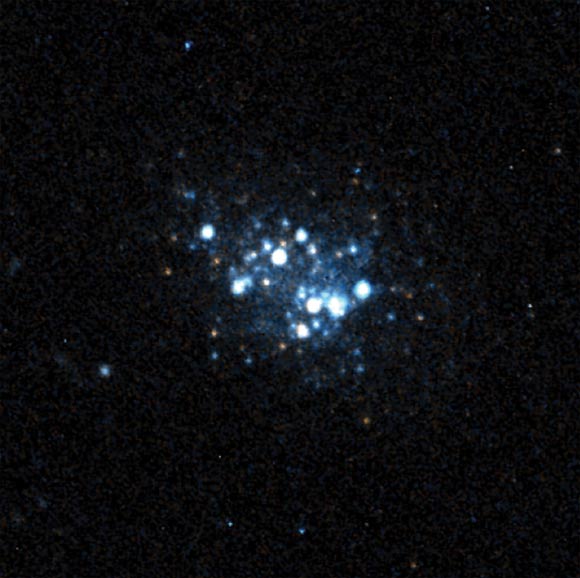Astronomers report that they have observed the most metal-poor galaxy ever seen in the Local Universe, a region of space within about one billion light-years from Earth.

This Hubble Space Telescope image shows the nearby dwarf galaxy AGC 198691. Image credit: NASA / A. Hirschauer & J. Salzer, Indiana University / J. Cannon, Macalester College / K. McQuinn, University of Texas.
This faint galaxy, known as AGC 198691 or Leoncino Dwarf, is relatively nearby in the Universe – approximately 30 million light-years away.
It’s in the direction of the constellation Leo Minor but lies far beyond our own Milky Way Galaxy.
According to the astronomers, AGC 198691 contains the lowest level of heavy chemical elements (metals) ever observed in a gravitationally bound system of stars, and is considered a member of the Local Universe.
“Finding the most metal-poor galaxy ever is exciting since it could help contribute to a quantitative test of the Big Bang,” said co-author Prof. John Salzer, from Indiana University.
“There are relatively few ways to explore conditions at the birth of the Universe, but low-metal galaxies are among the most promising.”
“This is because the current accepted model of the start of the Universe makes clear predictions about the amount of helium and hydrogen present during the Big Bang, and the ratio of these atoms in metal-poor galaxies provides a direct test of the model.”
To find metal-poor galaxies, astronomers must look far from Milky Way. Our own Galaxy is a poor source of data due to the high level of heavier elements created over time by ‘stellar processing,’ in which stars churn out heavier elements through nucleosynthesis and then distribute these atoms back into the galaxy when they explode as supernovae.
“Low metal abundance is essentially a sign that very little stellar activity has taken place compared to most galaxies,” said lead author Alec Hirschauer, also from Indiana University.
A galaxy previously recognized to possess the lowest metal abundance was identified in 2005; however, AGC 198691 has an estimated 29% lower metal abundance.
Aside from low levels of heavier elements, AGC 198691 is unique in several other ways.
A so-called dwarf galaxy, it’s only about 1,000 light-years in diameter and composed of several million stars. The Milky Way, by comparison, contains 200 – 400 billion stars.
AGC 198691 is also blue in color, due to the presence of recently formed hot stars, but surprisingly dim, with the lowest luminosity level ever observed in a system of its type.
“We’re eager to continue to explore this mysterious galaxy. Low-metal-abundance galaxies are extremely rare, so we want to learn everything we can,” Prof. Salzer said.
The astronomers reported their results in the May 12 issue of the Astrophysical Journal (arXiv.org preprint).
_____
Alec S. Hirschauer et al. 2016. ALFALFA Discovery of the Most Metal-Poor Gas-Rich Galaxy Known: AGC 198691. ApJ 822, 108; doi: 10.3847/0004-637X/822/2/108







